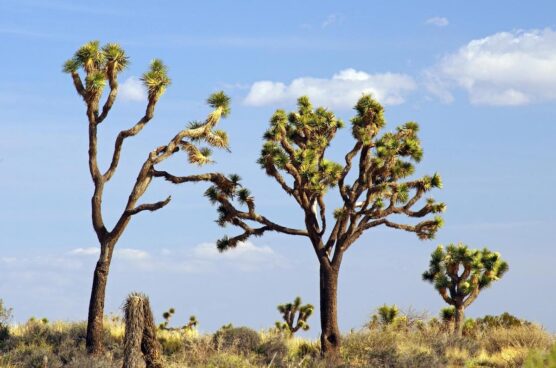By Sam Ribakoff
(CN) — Joshua trees will not be added to the endangered or threatened species list after the U.S. Fish and Wildlife Service decided the iconic symbols of the Mojave Desert don’t face any serious threats.
The decision, which will be published on Thursday, comes after a yearslong struggle with the environmental group WildEarth Guardians, which first petitioned the federal government to add Joshua trees to the endangered species list because of the effects of climate change. The federal government rejected the group’s petition, but the group then won a lawsuit which forced the agency to conduct the present study.
Fish and Wildlife projected the possible risks that two species of Joshua tree populations, the western and eastern species, in California, Arizona, Nevada and Utah have of becoming extinct between 2040 to 2069.
While noting climate change, wildfires, drought, and the invasive grasses as the biggest threats to Joshua trees, the agency concluded none of those factors will profoundly affect the population or range of the Joshua tree’s habitat.
“Joshua trees are projected to experience increases in average summer temperature of approximately 3.6–5.4 degrees Fahrenheit by 2040–2069, depending on the location,” the agency said in its report. “These temperature ranges are anticipated to be within the range of variability that Joshua trees have experienced in the recent past. Therefore, we consider that the majority (approximately 90%) of the current range of both species will continue to be occupied and viable in 2040–2069 and acknowledge the potential for the localized loss of occupied habitat in the warmest and driest portions of the ranges of both species.”
The agency said Joshua trees are long-living plants, with an age range of 150-300 years, and have been in their habitats for thousands of years, even during recent hotter temperatures.
But the agency noted the uncertainty regarding some of the projections made in the report, including its assessment of the effects of climate change and future policy decisions that could affect the severity of climate change.
The agency said it used the best available science in developing the report.
“WildEarth Guardians is incredibly disappointed that, for a second time, the USFWS has failed to follow clear science and law in declining to protect Joshua trees from the impacts of climate change, but sadly we’re also not surprised,” Lindsay Larris, the wildlife program director for WildEarth Guardians, said in a statement. “The intent of the ESA is not to wait until a species is on life support before it can receive any federal protection. This is yet another example of the federal government failing to protect a species before it is too late. We should be proactively putting imperiled species on the path to recovery, not dooming them to hover on the brink of extinction if we truly value preserving biodiversity in this country.”
Larris said the agency only focused on adult Joshua trees and didn’t take into account the effect climate change has on juvenile trees or the trees’ ability to reproduce. Nor did the agency study the actual dangers wildfires pose, since in 2020, the Dome Fire incinerated 1.3 million Joshua trees in a part of the Mojave National Preserve called the Cima Dome.
According to Fish and Wildlife’s own modeling of climate change’s effect on Joshua trees, “by the end of the century they’ll be wiped out of 90% of their range,” Larris said.
Larris said WildEarth Guardians may take the agency back to court.
In a statement, Fish and Wildlife stood by its findings.
“Through our scientific assessment, the service determined that Joshua trees will remain an iconic presence on the landscape into the future. Although the two species do not need the protections of the Endangered Species Act, the service cares deeply about Joshua trees and their roles in the desert environment,” Paul Souza, Pacific Southwest regional director of the Fish and Wildlife Service, said in a statement. “We are coordinating closely with partners to ensure the long-term conservation of these species, including the National Park Service and other federal agencies, and the state of California, which is also considering measures for the protection of Joshua trees.”
Two species of freshwater mussels fared better with Fish and Wildlife: the longsolid and round hickorynut mussels were added to the endangered species list on Wednesday.
The mussels, which live in rivers throughout the Midwest and South, face “habitat degradation or loss from a variety of sources (e.g., dams and other barriers, resource extraction); degraded water quality from chemical contamination and erosion from development, agriculture, mining, and forest conversion; direct mortality from dredging; residual impacts (reduced population size) from historical harvest; and the proliferation of invasive, nonnative species,” according to the agency.
The decision designates critical habitat for the mussels in portions of rivers in Pennsylvania, Kentucky, West Virginia, Virginia, Tennessee, and Alabama, Ohio, Indiana and Mississippi.
Like this:
Like Loading...
Related





 Tweet This
Tweet This Facebook
Facebook Digg This
Digg This Bookmark
Bookmark Stumble
Stumble RSS
RSS


























REAL NAMES ONLY: All posters must use their real individual or business name. This applies equally to Twitter account holders who use a nickname.
0 Comments
You can be the first one to leave a comment.